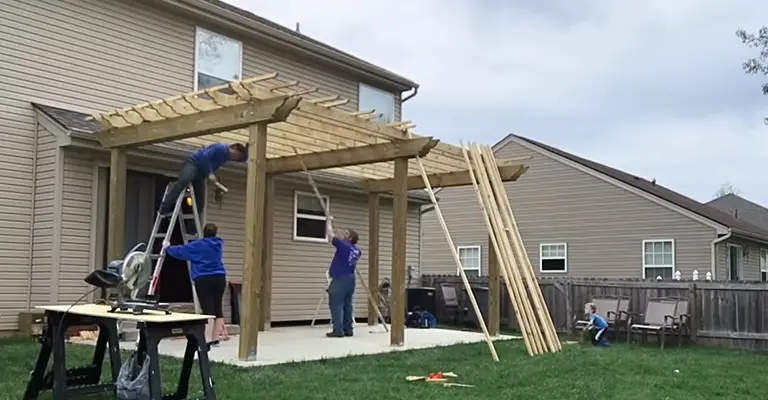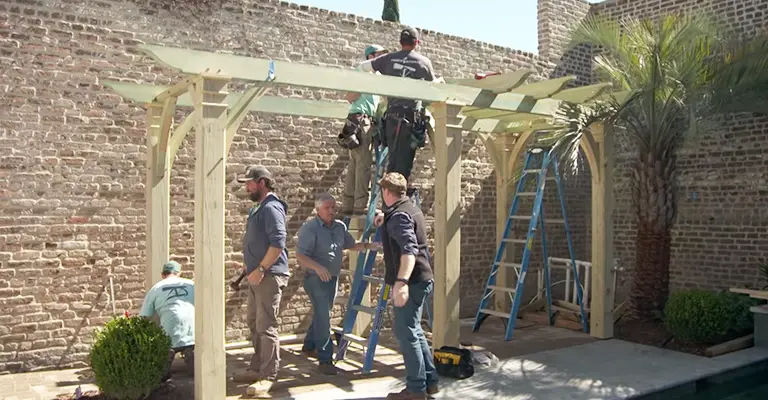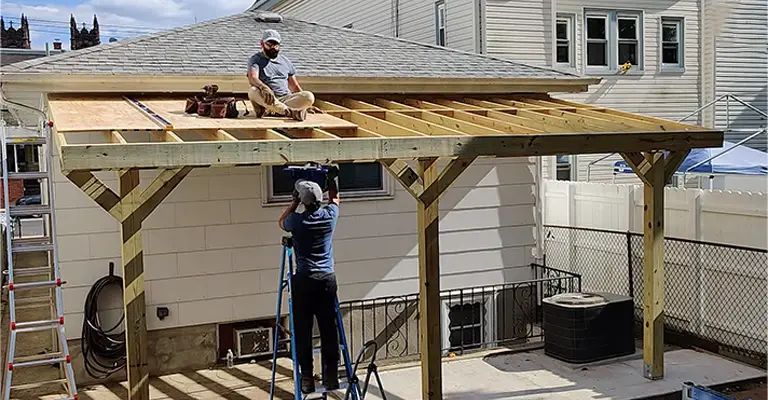A pergola is a fantastic addition to any outdoor space, providing a stylish and functional retreat where you can relax, entertain, and bask in the beauty of nature.
When planning your pergola project, one of the critical considerations is determining the ideal distance between your pergola and your house. Getting this distance right is essential for both aesthetic appeal and practicality.
A pergola makes a welcoming outdoor retreat, allowing in fresh air, gentle breezes, and dappled sunlight, whether it is attached to the house or freestanding.
Pergolas are typically built from posts topped by beams and rafters and have a ceiling height between 8 and 12 feet. In addition to defining an alfresco dining area, it can provide a shelter for an outdoor kitchen when set on a deck or patio.
When installed in the yard, it can create a garden destination, frame a fire-pit seating area, shelter poolside lounge chairs, or serve as a passageway between gardens.
There are many materials, styles, and extras available, regardless of whether it’s a DIY project or a custom installation.
How Far Should A Pergola Be From The House?
It is generally recommended that you place a pergola at least 8 to 10 feet away from your house to prevent any moisture issues.

Importance Of Determining The Appropriate Distance Between A Pergola And A House
While it may be tempting to place your pergola as close to your house as possible, careful consideration must be given to its placement.
The distance between your pergola and house affects not only the structural integrity and maintenance but also the overall visual harmony and practicality of the space.
In the following sections, we will explore the factors to consider when determining the ideal distance, providing guidelines and insights to help you make an informed decision.
Determining the ideal distance for your pergola from your house involves considering various factors such as aesthetics, safety, accessibility, and functionality.
While there is no one-size-fits-all answer, here are some key points to consider when deciding how far your pergola should be from your house:
Aesthetic Harmony
The placement of a pergola in relation to your house greatly influences the overall aesthetic harmony. Your pergola should visually complement your house and create a seamless transition between indoor and outdoor spaces.
Consider the architectural style, colors, and materials of your home, and aim for a placement that enhances the overall aesthetic appeal.
Aim for a placement that creates a seamless transition between the indoor and outdoor spaces, enhancing the visual appeal of both.
Take into account the proportions of your house and the pergola. A well-proportioned pergola should complement the size and style of your house without overpowering or appearing out of place.
Additionally, consider the architectural style of both the house and the pergola to ensure a cohesive and pleasing visual impact.
Safety and Structural Integrity

It’s crucial to ensure that your pergola is structurally sound and won’t compromise the integrity of your house.
Placing a pergola too close to your house can create safety hazards. Ensure that there is sufficient clearance from windows, doors, and other structures to prevent potential damage or obstruction.
Leave enough space to avoid any potential damage to your home’s foundation, walls, or roof. Consider the maintenance requirements of both the pergola and your house.
Leave enough space for easy access to clean and maintain the pergola, as well as access to gutters and downspouts for proper drainage.
Adequate space will make routine maintenance tasks more convenient. Consult with a professional if you have concerns about the structural impact.
Functionality and Accessibility
Think about how you plan to use your pergola. If you want it to serve as an extension of your living space, you may prefer it to be closer to your house for easy access.
However, if you desire a separate outdoor retreat, placing it further away can create a sense of privacy and tranquility.
Finding The Right Balance Between Proximity And Functionality
Finding the ideal distance is a delicate balance between proximity to the house and ensuring the pergola’s functionality.
Experiment with different placement options by mapping out the area and visualizing how the pergola will interact with the house and surrounding landscape.
Consider creating a scaled drawing or using virtual design tools to help you visualize the placement.
Sun and Shade Considerations
Evaluate the sun’s path and how it will interact with your pergola throughout the day. If you want to maximize shade, placing the pergola on the side of your house that receives the most sun can provide relief during hot summer months.
Determine if you prefer more sunlight or shade in your outdoor space. Additionally, assess wind patterns and potential privacy concerns to find the optimal placement that balances these factors.
Evaluate how the placement of the pergola will interact with existing outdoor spaces, such as patios, gardens, or pools.
Ensure that it does not disrupt the flow or functionality of these areas. Take into account the impact on landscaping and plan accordingly to maintain a cohesive and inviting outdoor environment.
Local Regulations and Permits
Check with your local building codes and regulations to ensure compliance. Some jurisdictions may have specific guidelines regarding setbacks and distances for structures attached to or near houses.
Can You Put A Pergola Next To A House?
You can attach a pergola to your home. Pergolas can be wall-mounted or freestanding depending on where they will be installed and how they will be used.
When attached to the house, pergolas can create seamless transitions to patios, pool decks and outdoor kitchens, whereas freestanding pergolas can provide a serene retreat away from the busy home.
Do I Need A Building Permit For A Pergola Attached To The House?
States, counties, and cities have different building codes. If you choose a licensed contractor with experience in obtaining building permits, you will know the requirements for your area.
Structures like pergolas often require building permits, and some coastal regions require hurricane-rated outdoor living structures.
Final Words
Ultimately, finding the perfect distance for your pergola from your house requires a balance between aesthetics, safety, and functionality.
Take the time to plan, consider your specific needs and preferences, and don’t hesitate to seek advice from professionals if necessary.
With careful consideration, you can create an outdoor oasis that seamlessly integrates with your home while providing a haven for relaxation and enjoyment.







